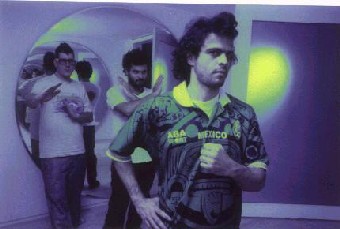


 |


Moreno Veloso is in the vanguard of the new generation of Brazilian singers and composers. While only 27, he has already accomplished many years of touring experience with the likes of Gilberto Gil and his father, the legendary samba poet and founding father of Tropicalismo, Caetano Veloso.
Like his father, Veloso's talent is multidimensional, leaving many people curious as to why it has taken him so long to release his first album. He's been a little preoccupied completing his doctorate in physics, a field in which he is also a rising star. Like other leaders of the new Brazilian sound, Bebel Gilberto and Vinicius Cantuaria, Veloso succeeds in taking the parts of Brazilian music that he knows and loves, and weaves those sounds with the noises of the new millennium--he brings a slight electronic edge to the samba, and a discreet phat beat to the bossa nova. In ironic contrast to the now outdated machine its title employs, Music Typewriter is a sophisticated work that heralds the arrival of the future generation of Brazilian music.
Moreno on the making of Music Typewriter:
"When I was invited by Carlos Barmak to reinagurate the small concert room at the Museum of Modern Art in Sao Paulo, I called two friends to organize the show. One of them was [Alexandre] Kassin, who would play the bass, and the other was Domenico [Lancelloti], who would play electronic percussion and paint the stage with soundscapes.
We were a trio. As repertoire I chose songs that represented my life--some songs of my own, some by my friends. We performed in a more coherent way than we could imagine and the result was simple and beautiful. Then came the idea of transforming that performance into a record. I decided that what we had already as content was enough, and along with Kassin I started organizing myself in order to work.
We rented a house in the woods, up in Petropolis. We took the equipment we had, and counted on the help of some friends. All of us worked hard in the brand new recording studio we had created.
The unique architecture of the house, with its walls made of stone and glass, its spooky rooms and mirrors, provided us with an environment as peculiar as the sounds we intended to record. We spent three months there during wintertime.
Once the initial recording step was finished, we came down from the mountains and compiled the songs at the studios of Chico Neves, Daniel Jobim, and Dado Villa-Lobos. After having spent nine months shaping the project we invited Andres Levin to help us to finish it. We flew to New York to meet him and we--Moreno + 2--along with his crew, finally finished the job.
All people that I involved in this record represent a web of friendship, a web that created the final sound of Music Typewriter.
Moreno
October 2000











